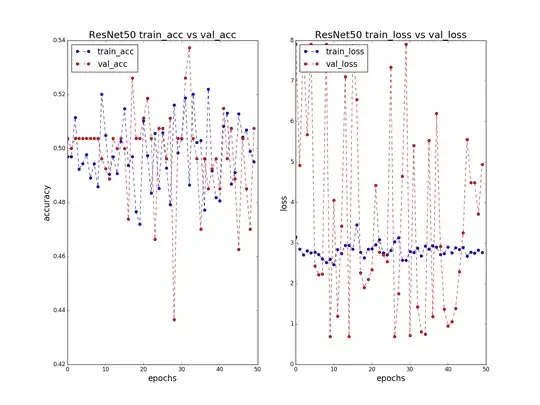I am practicing with Resnet50 fine-tuning for a binary classification task. Here is my code snippet.
base_model = ResNet50(weights='imagenet', include_top=False)
x = base_model.output
x = keras.layers.GlobalAveragePooling2D(name='avg_pool')(x)
x = Dropout(0.8)(x)
model_prediction = keras.layers.Dense(1, activation='sigmoid', name='predictions')(x)
model = keras.models.Model(inputs=base_model.input, outputs=model_prediction)
opt = SGD(lr = 0.01, momentum = 0.9, nesterov = False)
model.compile(loss='binary_crossentropy', optimizer=opt, metrics=['accuracy']) #
train_datagen = ImageDataGenerator(rescale=1./255, shear_range=0.2, zoom_range=0.2, horizontal_flip=False)
test_datagen = ImageDataGenerator(rescale=1./255)
train_generator = train_datagen.flow_from_directory(
'./project_01/train',
target_size=(input_size, input_size),
batch_size=batch_size,
class_mode='binary')
validation_generator = test_datagen.flow_from_directory(
'./project_01/val',
target_size=(input_size, input_size),
batch_size=batch_size,
class_mode='binary')
hist = model.fit_generator(
train_generator,
steps_per_epoch= 1523 // batch_size, # 759 + 764 NON = 1523
epochs=epochs,
validation_data=validation_generator,
validation_steps= 269 // batch_size) # 134 + 135NON = 269
I plotted a figure of the model after training for 50 epochs:
You may have noticed that train_acc and val_acc have highly fluctuated, and train_acc merely reaches 52%, which means that network isn't learning, let alone over-fitting the data.
As for the losses, I haven't got any insights.
Before training starts, network outputs:
Found 1523 images belonging to 2 classes.
Found 269 images belonging to 2 classes.
Is my fine-tuned model learning anything at all?
I'd appreciate if someone can guide me to solve this issue.
